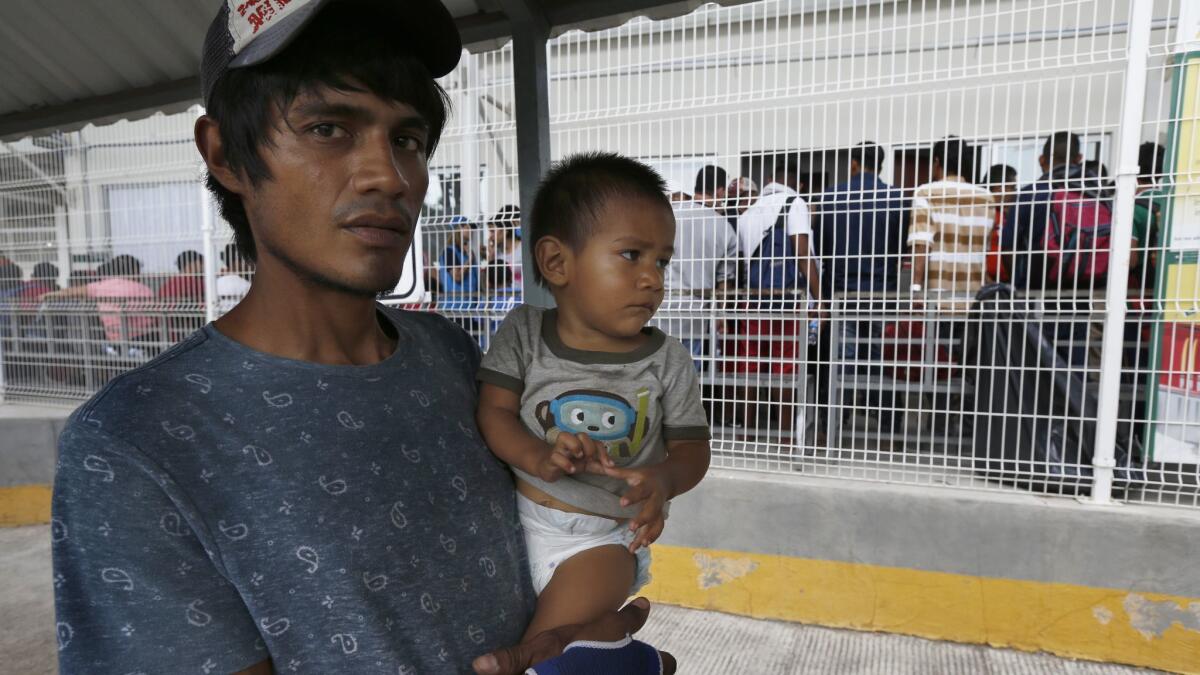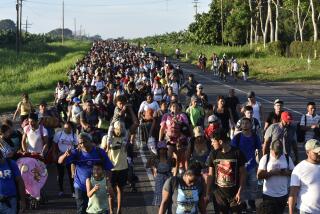Latest migrant caravan begins arriving in southern Mexico

Reporting from Ciudad Hidalgo, Mexico — Hundreds of U.S.-bound migrants in the latest caravan of Central Americans have arrived in southern Mexico, where authorities were processing them in an orderly fashion for temporary immigration status.
The migrants began reaching the Guatemalan-Mexican border late Wednesday, and by midday Thursday scores were lining up on the bridge spanning the Suchiate River, which forms the international boundary between the two countries.
Late Thursday, Mexican authorities said they had processed 1,114 people from Honduras, El Salvador, Guatemala and Nicaragua — including 969 adults and 145 minors — for humanitarian visas.
The calm scene stood in stark contrast to that at the same spot last October, when migrants from a previous caravan engaged in fierce clashes with Mexican police at the border. This time, no police were deployed and the migrants queued up calmly.
Some 2,000 migrants are expected to seek entry to Mexico as part of the latest caravan. As in past caravans, most participants are Honduran nationals fleeing poverty and violence in their Central American homeland who passed through Guatemala on their way north. Many said they hoped to join loved ones already in the United States.
“In our country there is no work; we are dying of hunger or of bullets,” Javier Lopez, 22, told Diario del Sur, a newspaper in nearby Tapachula, Mexico.
Lopez said he was heading to the United States to seek “a new life,” and had no intention of ever returning to his native Honduras.
The caravan phenomenon has long drawn the ire of President Trump, who has labeled the organized journeys “an invasion” and a threat to U.S. security.
Earlier this week, Trump cited the latest caravan as a reason why Congress should fund a multibillion-dollar wall along the U.S.-Mexico border. A dispute about the efficacy of a wall has resulted in a partial shutdown of the U.S. government, even as the latest caravan heads north.
There was no reported violence as caravan participants waited calmly for inspection by Mexican immigration agents stationed at the entry gate leading from Guatemala. Mexican officials provided bottles of water to the migrants gathered in the open air beneath a relentless tropical sun.
In contrast to October, there were no police helicopters hovering overhead or Mexican police in riot gear on the scene.
“The [Mexican] officials are being very nice,” Jose Lira, a young Honduran man, told Diario del Sur. “We don’t want any fighting. We just want to get to the United States.”
When told that Trump didn’t want the migrants to settle in the United States, Lira responded: “Yes, but we only want to go to his country to work. ... We are not bad people, we just want a better life.”
Many are expected to seek political asylum in the United States, even though relatively few Central Americans qualify. And while adult asylum applicants may face long waits in U.S. immigration detention lockups, minors and parents traveling with minor children may be released on bond while their asylum applications work their way through U.S. immigration courts, a process that can take months or years.
Participants say caravans provide security from Mexican gangs that often prey on migrants and avoid the need to pay smugglers thousands of dollars to aid them on the trip north. Caravan members often receive free food, transport and lodging from residents, towns and aid agencies along the route, though many sleep in the open without shelter.
The latest caravan left the Honduran city of San Pedro Sula earlier this week. .
The influx of caravan members into Mexican territory is expected to continue for several days as individuals and groups still walking or trying to catch rides make it to the Mexican frontier.
A separate caravan of several hundred people was also en route to Mexico from El Salvador.
While many set out on foot, most caravan members appeared to have secured rides for much of the trip from Honduras.
Guatemalan immigration authorities counted 1,701 people in the latest caravan, though migrant advocacy groups said those numbers did not include some who crossed illegally from Honduras into Guatemala, and others who joined in Guatemala.
Of the 1,701 counted, Guatemalan immigration authorities said that 1,219 (or 72%) were male and 482 (28%) were female. The caravan included 325 minors, about 19% of the total.
Like earlier caravan travelers, many say they seek to reach the United States, more than 1,000 miles to the north. But others have indicated they may be receptive to offers from Mexican authorities to remain in Mexico and find work. Some may apply for refugee status in Mexico.
“The United States is not allowing us to enter easily, so I’d have to go illegally…. It’s dangerous,” said Ernesto Centeno, 28, a construction worker from Tegucigalpa, the Honduran capital, who was among those hopeful of finding employment in Mexico.
Mexican officials made no effort to stop the flow, and the international bridge remained open in both directions. But Mexico was requiring that all register to receive documents allowing them to remain in Mexico for humanitarian reasons. Officials fitted migrants being processed with plastic bracelets to identify them and their cases.
“My mission is to cross into the United States,” said Wendy Jaquelin Lobos, 25, who was traveling with two of her four children, a son, 6, and a daughter, 8 — both carrying backpacks — and was waiting in line for a Mexican visa. Her other children remained at home in Honduras with her mother, she said.
“Life in Honduras is difficult, especially economically,” said Lobos, who is from the Honduran town of Quimistan.
Like others, she was drawn to the caravan by posts on social media and news reports.
Mexican President Andres Manuel Lopez Obrador, who took office Dec. 1, has said that the migrants would be welcome and have the opportunity to gain legal residency and work permits in Mexico if they chose to remain in this country.
“We are putting in place a protocol … to be able to give them a dignified treatment with respect of the human rights of all the migrants,” David Leon, who heads Mexico’s civil protection efforts, told Reforma newspaper.
The plan was for caravan members to be transported to shelters in the border area. They would probably remain in the shelters for five days until their immigration paperwork was ready, allowing them to travel legally in Mexico.
In October, several thousand members of an earlier caravan toppled fences on the Guatemalan side and clashed with Mexican police on the bridge over the Suchiate River.
On that occasion, the heavy deployment of Mexican police — who fired tear gas to disperse the migrants — prevented the Central Americans from storming the border.
Many who retreated later crossed illicitly into Mexico, swimming a short distance across the Suchiate or catching rides on rafts crafted of inner tubes and wooden planks. They eventually regrouped on the Mexican side and headed north, without impediments from Mexican police.
Some 6,000 migrants from that caravan and several subsequent caravans eventually made it in November to Tijuana, across from San Diego.
This time, however, there was no need for the caravan travelers to try and sneak into Mexico via the river.
Special correspondent Averbuch reported from Ciudad Hidalgo and Times staff writer McDonnell from Mexico City. Cecilia Sanchez in The Times’ Mexico City bureau contributed to this report.
Twitter: @PmcdonnellLAT
More to Read
Sign up for Essential California
The most important California stories and recommendations in your inbox every morning.
You may occasionally receive promotional content from the Los Angeles Times.










